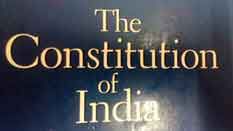Doctrine Of Basic Structure: Enabler And Culminator Of Governance
The doctrine of basic structure is considered to be a remarkable innovation
to the theory of constitutionalism in that it has limited the powers of
parliament over constitutional amendments. Primarily the discourse that led to
the emergence of the doctrine revolved around the scope of 'constitutional
amendment' in the definition of law and secondly, the distinction between
parliamentary and constituent power. Later, the subsequent cases raised the
question that 'does the basic structure only limits itself to constitutional
amendments' or 'whether it potentially determines the constitutionality of
ordinary law also.'
The jurisprudential aspect of this debate is backed by Kelsen's school of thought which interestingly comes out to the conclusion to extend the doctrine to ordinary legislation. However, before accepting the extension of the basic structure of the ordinary laws its implications of restricting the evolving nature of constitutional application should also be taken into consideration.
However, the development of the stuporous Doctrine of Basic Structure has also been sometimes criticized for judicial overreach in adjudicating the affirmative actions of the government. P.P. Rao in his book Reclaiming the Vision writes that "the vague concept from the majority judgment of Kesavananda Bharati has made judiciary as the most powerful wing of 'State' as compared to legislature and executive."
This vagueness of the doctrine seems like a two-sided sword that if in an extraordinary situation not applied to the ordinary law can cause greater harm to Constitutional values. However, if categorically applied to ordinary legislation may hamper the construction of Constitutional goals via affirmative actions of legislative laws.
The discourse of this expansion is not a nuance to the Constitutional development. However, the objective of social transformation carried out through ordinary legislation and the effects of the application of doctrine limit such legislature beyond amending power may have another drawback on the progressive development of the Constitution.
This is because the instance of violation of the doctrine is unidentifiable in the first place for the legislature which may be expanded in any case by the judiciary. The view of Justice F. Nariman in the case of Madras Bar Assn. v. UOI was that the inviolable nature of the doctrine of basic structure extends its application to all legislature other than constitutional amendments.
Justice Mathew also pointed out this ambiguity in the case of Indira Nehru Gandhi v Raj Narain that keeping the rule of law as a component of basic structure brings subjectivity to the concerned principles of the provision challenged. Therefore, the elasticity of the doctrine has undefined powers of limiting the core functioning of the legislature. There is a tussle within the judiciary to bring certainty to it, which may also thwart the ground rooting of the values attempted to be preserved by the basic structure.
To ensure the same, the judiciary has been given extensive powers of limiting the government and protecting the rights of individuals. Besides this judiciary has more often played the role of an enabler in enforcing rights. However, it has also some or other ways been drawn into politics to achieve the long-term aspirations of the constitution.
This interrelation of politics and governance is often balanced by the judiciary. The intervention of the judiciary as an agent of individuals attempts to symmetrize the legislation and legislative actions by the rule of law. Thus, the rule of law becomes the basis of the Basic Structure Doctrine inter alia to judicial review.
The judiciary has time to time utilised its position to review the governmental actions to prevent abrogation of the main features of the basic feature for short-term political gains. The ideological commitments of political parties sometimes generate proposals for radical constitutional amendments. Several times judiciary has preserved the federal nature of the Constitution through interpretations.
The dissenting judgment of Justice Subba Rao in the case of State of West Bengal v Union of India has impacted subsequent judgments like Keshvananda Bharati to consider the federal nature of the constitution as a fundamental characteristic of it. In another case of State of Karnataka v. Union of India, the minority view was that the Union Government does not have overriding power over the State Government apart from the contingencies provided in the constitution i.e., no power beyond provisions of the constitution.
Thereafter, in the cases of S.R. Bommai case and Kuldip Nayar case, the court held that the nature of the Indian constitution is federal and the superior power also lies with the state government in its way. In other ways making political advantages through radical amendments, political mobilization and public policies may go against the the spirit of Constitution.
Therefore, constitutional interpretation of constituents of Basic Structure through adjudication has curtailed the use of political power to violate the constitutional pre-commitments outlined in the doctrines, without determining the outcomes of political processes.
Thereby, through the judicial reviews of various legislations and legislative actions, the examination of constitutionality has extensively led to the interpretation of the Constitution beyond the facts and circumstances of the particular cases. Thus, the Doctrine of Basic Structure has also provided extensive space for the development of the Constitution through adjudications.
The two major tests of constitutionalism are - legitimacy and accountability, which should be followed by the government while exercising its powers. It implies that a democratic government should function in a way that efficiently compels it to operate within constitutional limits. These are the fundamental values that persuade the government to be accountable to the people.
The responsibility of the government to exercise decision-making according to the rule of law is checked by the judiciary as custodian of those fundamental values of the constitution. Thereby, the function of the judiciary more than a mediator or adjudicator has also been an enabler of good governance, promoting integrity and smooth functioning of the government. Since basic structure has been the foundational principle of empowering basic structure, it has been the facilitator of good governance too.
Conclusion
The Doctrine of Basic Structure does give power to the judiciary over the other organs of the government. On the other hand, the scope of doctrine is also undefined and subjective. However, it is this nature of the Basic Structure of drawing thin lines of commitments that gives space to the nuances and enables flexibility and adaptability.
The judiciary while expanding its scope of the doctrine instead of overreaching functions effectively to protect the rights of individuals on the behalf of Constitution. However, in the absence of any yardsticks to the doctrine it is also recommended that some kind of fencing should be built as guiding principles to Parliament and prevent the laws from being stuck down on the ground of unconstitutionality. It would not only prevent multiple litigations but also enhance the applicability of affirmative action.
Thus, the re-examination of the Doctrine of Basic Structure is essential to reconcile the relationship of legislature and judiciary for better governance. Hence, the interrelation of political process and governance regulated by interception of the doctrine turns out to be societal transformation through the embedded constitutional roots.
Henceforth, it is recommended that for the progressive development of constitution it is essential that the stuporous doctrine should be framed by a committee involving the President, a Member of Parliament, senior-most Judges of the Supreme Court, Chief Justices of High Courts, prominent academicians, and lawyers. Additionally, the recommendation of the committee should also be open for the public view or referendum.
The jurisprudential aspect of this debate is backed by Kelsen's school of thought which interestingly comes out to the conclusion to extend the doctrine to ordinary legislation. However, before accepting the extension of the basic structure of the ordinary laws its implications of restricting the evolving nature of constitutional application should also be taken into consideration.
Effect Of The Doctrine Over Living Document
The Indian Constitution is considered a living document, which is not expressly perceivable from the bare text of the Constitution. But with time the progressive interpretation of the Constitution through amendments and judicial interpretation showed the farsightedness of the Constitution makers subsisting in the organic document. Additionally, the directive policies under Part IV of the constitution aimed to accelerate social transformation through legislation and administration.However, the development of the stuporous Doctrine of Basic Structure has also been sometimes criticized for judicial overreach in adjudicating the affirmative actions of the government. P.P. Rao in his book Reclaiming the Vision writes that "the vague concept from the majority judgment of Kesavananda Bharati has made judiciary as the most powerful wing of 'State' as compared to legislature and executive."
This vagueness of the doctrine seems like a two-sided sword that if in an extraordinary situation not applied to the ordinary law can cause greater harm to Constitutional values. However, if categorically applied to ordinary legislation may hamper the construction of Constitutional goals via affirmative actions of legislative laws.
The discourse of this expansion is not a nuance to the Constitutional development. However, the objective of social transformation carried out through ordinary legislation and the effects of the application of doctrine limit such legislature beyond amending power may have another drawback on the progressive development of the Constitution.
This is because the instance of violation of the doctrine is unidentifiable in the first place for the legislature which may be expanded in any case by the judiciary. The view of Justice F. Nariman in the case of Madras Bar Assn. v. UOI was that the inviolable nature of the doctrine of basic structure extends its application to all legislature other than constitutional amendments.
Justice Mathew also pointed out this ambiguity in the case of Indira Nehru Gandhi v Raj Narain that keeping the rule of law as a component of basic structure brings subjectivity to the concerned principles of the provision challenged. Therefore, the elasticity of the doctrine has undefined powers of limiting the core functioning of the legislature. There is a tussle within the judiciary to bring certainty to it, which may also thwart the ground rooting of the values attempted to be preserved by the basic structure.
Regulation Of Political Actions And Governance
After Independence, the making of the Constitution had certain objectives to be achieved in the long term through small steps, one such objective was good governance. This is also evident from the unique transformation of the Constituent Assembly to Parliament. The visions of the Constituent Assembly were as high as ensuring a participatory, accountable, transparent, and efficient structure of administration.To ensure the same, the judiciary has been given extensive powers of limiting the government and protecting the rights of individuals. Besides this judiciary has more often played the role of an enabler in enforcing rights. However, it has also some or other ways been drawn into politics to achieve the long-term aspirations of the constitution.
This interrelation of politics and governance is often balanced by the judiciary. The intervention of the judiciary as an agent of individuals attempts to symmetrize the legislation and legislative actions by the rule of law. Thus, the rule of law becomes the basis of the Basic Structure Doctrine inter alia to judicial review.
The judiciary has time to time utilised its position to review the governmental actions to prevent abrogation of the main features of the basic feature for short-term political gains. The ideological commitments of political parties sometimes generate proposals for radical constitutional amendments. Several times judiciary has preserved the federal nature of the Constitution through interpretations.
The dissenting judgment of Justice Subba Rao in the case of State of West Bengal v Union of India has impacted subsequent judgments like Keshvananda Bharati to consider the federal nature of the constitution as a fundamental characteristic of it. In another case of State of Karnataka v. Union of India, the minority view was that the Union Government does not have overriding power over the State Government apart from the contingencies provided in the constitution i.e., no power beyond provisions of the constitution.
Thereafter, in the cases of S.R. Bommai case and Kuldip Nayar case, the court held that the nature of the Indian constitution is federal and the superior power also lies with the state government in its way. In other ways making political advantages through radical amendments, political mobilization and public policies may go against the the spirit of Constitution.
Therefore, constitutional interpretation of constituents of Basic Structure through adjudication has curtailed the use of political power to violate the constitutional pre-commitments outlined in the doctrines, without determining the outcomes of political processes.
Doctrine As Culmination Of Constitutional Development
It is pertinent to note that the three organs of the government maintain a check and balance using the powers conferred upon them by the Constitution. The political power of the legislature may have a huge impact on the lives of people provided that they should also be legitimate and accountable. To monitor the same the judiciary can review the legislations, rules, and actions of the government on the basis featured by the Doctrine of Basic Structure.Thereby, through the judicial reviews of various legislations and legislative actions, the examination of constitutionality has extensively led to the interpretation of the Constitution beyond the facts and circumstances of the particular cases. Thus, the Doctrine of Basic Structure has also provided extensive space for the development of the Constitution through adjudications.
The two major tests of constitutionalism are - legitimacy and accountability, which should be followed by the government while exercising its powers. It implies that a democratic government should function in a way that efficiently compels it to operate within constitutional limits. These are the fundamental values that persuade the government to be accountable to the people.
The responsibility of the government to exercise decision-making according to the rule of law is checked by the judiciary as custodian of those fundamental values of the constitution. Thereby, the function of the judiciary more than a mediator or adjudicator has also been an enabler of good governance, promoting integrity and smooth functioning of the government. Since basic structure has been the foundational principle of empowering basic structure, it has been the facilitator of good governance too.
Conclusion
The Doctrine of Basic Structure does give power to the judiciary over the other organs of the government. On the other hand, the scope of doctrine is also undefined and subjective. However, it is this nature of the Basic Structure of drawing thin lines of commitments that gives space to the nuances and enables flexibility and adaptability.
The judiciary while expanding its scope of the doctrine instead of overreaching functions effectively to protect the rights of individuals on the behalf of Constitution. However, in the absence of any yardsticks to the doctrine it is also recommended that some kind of fencing should be built as guiding principles to Parliament and prevent the laws from being stuck down on the ground of unconstitutionality. It would not only prevent multiple litigations but also enhance the applicability of affirmative action.
Thus, the re-examination of the Doctrine of Basic Structure is essential to reconcile the relationship of legislature and judiciary for better governance. Hence, the interrelation of political process and governance regulated by interception of the doctrine turns out to be societal transformation through the embedded constitutional roots.
Henceforth, it is recommended that for the progressive development of constitution it is essential that the stuporous doctrine should be framed by a committee involving the President, a Member of Parliament, senior-most Judges of the Supreme Court, Chief Justices of High Courts, prominent academicians, and lawyers. Additionally, the recommendation of the committee should also be open for the public view or referendum.
Law Article in India
Legal Question & Answers
Lawyers in India - Search By City
LawArticles
How To File For Mutual Divorce In Delhi

How To File For Mutual Divorce In Delhi Mutual Consent Divorce is the Simplest Way to Obtain a D...
Increased Age For Girls Marriage

It is hoped that the Prohibition of Child Marriage (Amendment) Bill, 2021, which intends to inc...
Facade of Social Media

One may very easily get absorbed in the lives of others as one scrolls through a Facebook news ...
Section 482 CrPc - Quashing Of FIR: Guid...

The Inherent power under Section 482 in The Code Of Criminal Procedure, 1973 (37th Chapter of t...
The Uniform Civil Code (UCC) in India: A...

The Uniform Civil Code (UCC) is a concept that proposes the unification of personal laws across...
Role Of Artificial Intelligence In Legal...

Artificial intelligence (AI) is revolutionizing various sectors of the economy, and the legal i...








Please Drop Your Comments